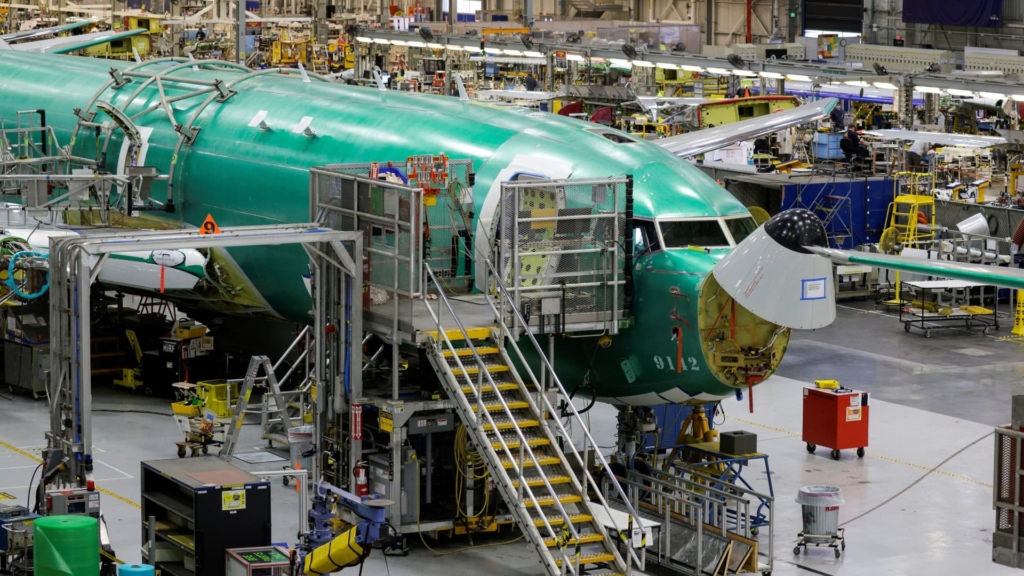President Donald Trump’s extensive tariffs are poised to escalate the costs of Boeing and Airbus aircraft, as well as GE Aerospace engines and a wide array of other products within the aerospace and defense sectors. This shift threatens an industry that reportedly alleviates the U.S. trade deficit by over $100 billion annually.
“These tariffs undeniably increase costs for the industry,” stated Dak Hardwick, the vice president of international affairs at the Aerospace Industries Association, an organization that includes Boeing, GE Aerospace, Airbus, and a multitude of aerospace and defense companies.
The Aerospace Industries Association is urging the Trump administration to maintain provisions of a trade agreement that has been in place for nearly 50 years, which allows for tariff-free trade of civilian aircraft and defense-related imports.
“The requests to the White House are numerous,” Hardwick remarked, indicating a significant backlog of appeals.
Trump’s executive order announcing the tariffs attributes the downtrend in U.S. manufacturing to global trade and economic policies.
The order emphasizes the need for a robust domestic manufacturing ecosystem to support innovation in the defense sector, stating that it is crucial for the U.S. to minimize its dependence on imports for essential components needed for national security.
Traditionally, the aerospace industry has been a leading exporter for the United States. According to company data, Boeing has secured over two-thirds of its airplane orders from international customers in the past decade.
“Free trade is imperative for our business,” asserted Boeing CEO Kelly Ortberg during a Senate hearing. “We exemplify an export-driven company, generating long-term, high-value jobs in the U.S. Maintaining access to international markets is vital to avoid a scenario where certain markets close off to us.”
The aerospace sector has benefitted from a 45-year-old trade agreement that permits the duty-free exchange of planes and parts. However, this arrangement could be jeopardized by Trump’s new tariffs, which impose a 10% tax on various countries, with even higher tariffs for certain regions, including Europe—an essential area for the aerospace industry.
Additionally, recently announced tariffs on imported steel and aluminum—vital materials for aircraft construction—add another layer of complexity to the situation.
“President Trump has made it clear: if you produce your goods in America, tariffs won’t be a concern,” White House spokesperson Kush Desai noted in an email.
With tariffs imposed on the importer, the resulting price increases will need to be absorbed either by the plane or engine manufacturers, the still-vulnerable supply chain, or the end consumer, Hardwick explained.
Analyst Sheila Kahyaoglu from Jefferies noted in a report that any price rise in products within the first 12 months will likely be covered by the original equipment manufacturer; beyond that, costs will ultimately fall on the buyer and the consumer.
Aircraft pricing typically involves advance negotiations, with airlines often waiting years for delivery. This timeline can lead to significant shifts in material costs during the waiting period.
“This isn’t comparable to buying a car, where you make a down payment and receive it in three months,” Hardwick pointed out.
Following the announcement of the tariffs on Wednesday, stocks for Boeing, GE, and various airlines faced notable declines, exacerbating the market turmoil.
“The aerospace sector has long enjoyed a substantial trade surplus for the United States,” remarked Richard Aboulafia, managing director at AeroDynamic Advisory. “It’s illogical to instigate a trade conflict within an industry that is thriving so well.”
Global supply chain
The new tariffs introduce additional pressure on the aerospace industry, which has been recovering from supply chain disruptions caused by COVID-19, with many components remaining in short supply. Major manufacturers are struggling to recruit workers and increase production to meet the surge in post-pandemic travel demand.
Despite these challenges, airplane manufacturers have yet to catch up with soaring demands.
Even the labeling of an airplane as “Made in the USA” can be misleading.
For instance, the assembly of a Boeing 787 Dreamliner takes place in South Carolina, yet its supply chain extends across borders, encompassing elements sourced from Japan to Italy.
Similarly, Airbus operates a factory in Mobile, Alabama, while still incurring tariff costs on parts imported from various locations, including wings and fuselages.
“Ownership of the company is irrelevant. Any item crossing the border incurs tariffs payable by the importer,” Hardwick noted.
Airbus has invested in its Alabama facility, which initially assembled the Airbus A321 for JetBlue Airways, now nine years old, and has expanded operations to include smaller A220s for JetBlue and Delta Air Lines.
Continuing along the supply chain, General Electric and France’s Safran have established a partnership for the production of popular CFM engines that power both Boeing and Airbus narrow-body planes. Each company handles different components, which are then sent to facilities in Ohio, Indiana, North Carolina, and outside Paris for final assembly.
The price of thousands of imported replacement parts, along with other aircraft components that predominantly come from overseas, may also rise due to these tariffs.
“National planes are a myth,” stated Aboulafia succinctly.


























